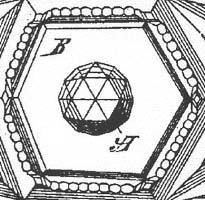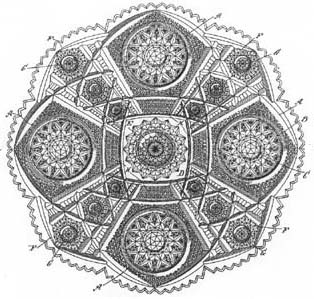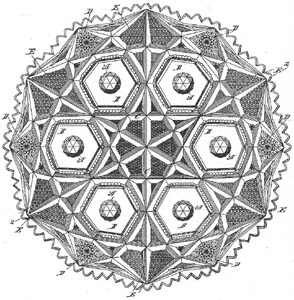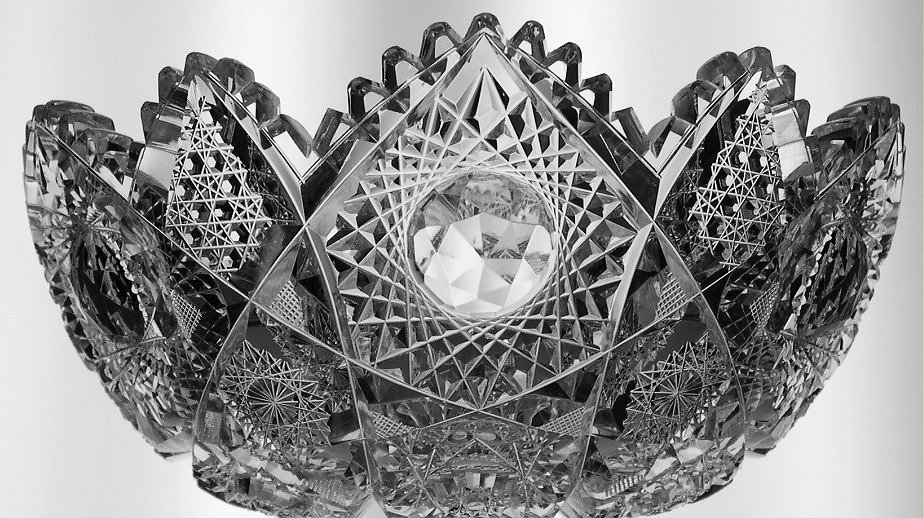

The term "rose-cut diamond" is taken from the jewelry industry where it refers to "a style of cutting a diamond into a flat-bottomed hemisphere with a curved upper surface covered with triangular facets" (NEW SHORTER OED). Although this style is passé today, one can occasionally find colored rose-cut "jewels" set in panes of leaded glass and in costume jewelry of an earlier day.
In cut glass T. B. Clark showed, in his Waldorf pattern of 1899 (pat. no. 30,086), that it is possible to cut a hobstar's hobnail in the rose-cut diamond style. Pearson logically calls this type of hobstar a "rose diamond hobstar" (ENCYCLOPEDIA, Vol. 1, p. 185). During 1900 Clark patented a second pattern, no. 32,150, that also uses the rose-cut diamond but in this case not as part of a hobstar. While the official name of this pattern is not known, it has been assigned the name "Lapidary Center" (Revi 1965, p. 288).
The following close-ups of the rose-cut diamond are taken from the accompanying Clark patent-drawings: pat. no. 30,086 (Waldorf pattern) on the left, and pat. no. 32,150 ("Lapidary Center" pattern) on the right. The drawings are "inverted plan views" (i.e., the drawings show the items' cut sides):




The specification for pat. no. 30,086 contains the comment that "The leading feature of the design is the lapidary center . . . that is to say, a center [i.e., hobnail] cut with faces in imitation of a diamond . . ." While the hobnail here is the center of a 10-pt hobstar, there is no hobstar in pat. no. 32,150. Instead, the rose-cut diamond hobnail is shown "rising on a plane-surfaced polygonal figure B". (Incidentally, this pattern's mitered outline was used by Clark for his earlier Venus pattern, c1896.)
Revi, who included both of these patents in his book, did not at the time have access to a 1901 Clark catalog wherein one finds, probably for the first time, examples of the rose-cut diamond motif, as it appears in pat. no. 30,086. As a result, Revi coined the name "Quatrafoil Rosette" for this pattern, a pattern the catalog calls Waldorf. The 1901 catalog shows many examples of the Waldorf pattern. While the patented design is altered slightly on some of them, they are all called Waldorf. An example of this altered design is illustrated in Pearson's ENCYCLOPEDIA (Vol. 1, p. 185, lower). "Quatrafoil Rosette" is also the name used by Wiener and Lipkowitz in their book of cut-glass rarities that was published in 1977, and in which there are three examples of this pattern.
The "rarities" book also contains two examples of an unnamed pattern that contains rose-cut diamond hobnails as centers of multi-pointed hobstars. The only other motif in the pattern is hexad. A two-part punch bowl in this pattern, p. 177, has spectacular 60-pt hobstars. This pattern has also been seen with 48-pt hobstars on a 10"D bowl (p. 22) and with 40-pt hobstars on a 9"D bowl (ENCYCLOPEDIA, Vol. 1, p. 185). With its close cutting, hobstars with high point-counts, and rose-cut diamond hobnails, this pattern is one of the most impressive of all the patterns that were cut during the brilliant period.
In addition to the Waldorf pattern, the 1901 Clark catalog contains a second pattern that uses the rose-cut diamond hobnails -- Orloff -- which has regular 24-pt hobstars. This pattern is also shown in the next catalog that is extant, that of 1905, where the Waldorf pattern has been dropped. This catalog also introduces two new patterns with rose-cut diamond hobnails: Angelus, where the rose-cut diamond hobnail is the center of a pinwheel, and Rembrandt, which has Orloff-style hobstars. While Rembrandt is represented by only one example, the Angelus pattern has nine. The next, and last, extant catalog that contains the rose-cut diamond hobnail is one dated about 1910. The only example therein is called Heroine. It has Waldorf-style hobstars, but the pattern is simpler and less expensive than Waldorf.
The rose-cut diamond motif has also appeared on a berry bowl that is discussed in an article by Leigh Emmerson that was published in 2002. Although neither the bowl's pattern-name nor its manufacturer are unknown, Emmerson supplies evidence that the bowl was produced by the Meriden Cut Glass Company. He calls the motif "rose cut diamond/lapidary hob" (note 1). The following is a profile view of the bowl that was used by Emmerson in his discussion. It re-appeared in a public auction four years later. Condition: "a few slight nicks". D = 8.3" (21.1 cm), H = 3.4" (8.7 cm), wt = 3 lb (1.4 kg). Sold for $671 at an eBay auction in 2006 (Image: Internet). This is an excellent image of the rose-cut diamond motif which is notoriously difficult to photograph clearly. (Note also the abutting nexad motif.)

Mentioned must also be made of patent no. 31,781 that was granted to William H. Gibbs on 7 Nov 1899. Its specification describes the pattern's "leading feature" as "a knob [i.e., hobnail] . . . provided with [a] circular border of half-diamond cuttings or faces". Although not strictly the rose-cut diamond motif, these hobnails are, nevertheless, related to it. This is not surprising because Gibbs, an expert glasscutter who received his basic training at C. Dorflinger & Sons, was also a founding-partner of Gibbs, Kelly & Company (originally Gibbs and Kelly, 1895) located in the town of Honesdale, PA where T. B. Clark & Company also had its factory. Gibbs was undoubtedly familiar with the rose-cut diamond hobnail of Clark's Waldorf pattern -- which had been patented earlier in 1899 -- when he turned Clark's rose-cut diamond hobnail into the "half diamond" mentioned in his patent's specification. The patent-drawing that is currently available from the USPTO is an improvement over the illustration of Gibbs' patent in Revi's book (p. 300). Given that Gibbs, Kelly & Company's name for its only patented pattern is not known, it is reasonable to call the pattern "Gibbs". This is a more appropriate name than "Circles" which the writer originally suggested a few years ago. Many additional details concerning W. H. Gibbs' long association with cut glass can be found in Barbe and Reed (2003).
The "Lapidary Center" pattern is rarer than Waldorf and its cousins. A Clark catalog containing it has yet to be discovered. The only actual example of the pattern known to the writer is one found in the Boggesses' IDENTIFICATION book, p. 191. That photograph, taken of a nappy's uncut side, illustrates the necessity of using an object's cut side when photographing any pattern that contains rose-cut diamond hobnails.
The rose-cut diamond hobnail, used alone, or, more usually, in combination with a hobstar, was cut during a relatively brief period of about five years. Fortunately, this period coincided with the height in popularity of cut glass in this country. The motif was, as a result, produced in a quantity that has insured its survival today, in spite of the fact that patterns that contain this motif were some of the most expensive ever produced by T. B. Clark & Company.
NOTE:
1. Emmerson, Leigh, 2002: No longer clueless, The Hobstar, Vol. 24, No. 4, pp. 8-13 (Jun).
Updated 5 Oct 2006